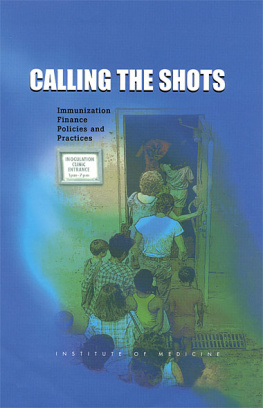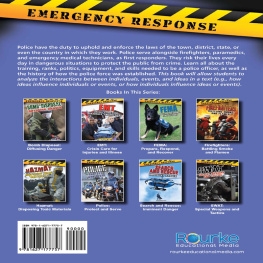NOTICE: The project that is the subject of this report was approved by the Governing Board of the National Research Council, whose members are drawn from the councils of the National Academy of Sciences, the National Academy of Engineering, and the Institute of Medicine. The members of the committee responsible for the report were chosen for their special competences and with regard for appropriate balance.
Support for this project was provided by Contract No. DASW01-97-C-0078 between the National Academy of Sciences and the U.S. Department of Defense. The views presented in this report are those of the Institute of Medicine Committee on Strategies to Protect the Health of Deployed U.S. Forces and are not necessarily those of the funding agency.
Additional copies of this report are available for sale from the National Academy Press, 2101 Constitution Avenue, N.W., Box 285, Washington, DC 20055. Call (800) 624-6242 or (202) 334-3313 (in the Washington metropolitan area), or visit the NAP's home page at
www.nap.edu. The full text of this report is available at
www.nap.edu.
For more information about the Institute of Medicine, visit the IOM home page at www.iom.edu.
Copyright 2000 by the National Academy of Sciences. All rights reserved.
Printed in the United States of America.
The serpent has been a symbol of long life, healing, and knowledge among almost all cultures and religions since the beginning of recorded history. The serpent adopted as a logotype by the Institute of Medicine is a relief carving from ancient Greece, now held by the Staatliche Museen in Berlin.
THE NATIONAL ACADEMIES
National Academy of Sciences
National Academy of Engineering
Institute of Medicine
National Research Council
The National Academy of Sciences is a private, nonprofit, self-perpetuating society of distinguished scholars engaged in scientific and engineering research, dedicated to the furtherance of science and technology and to their use for the general welfare. Upon the authority of the charter granted to it by the Congress in 1863, the Academy has a mandate that requires it to advise the federal government on scientific and technical matters. Dr. Bruce M. Alberts is president of the National Academy of Sciences.
The National Academy of Engineering was established in 1964, under the charter of the National Academy of Sciences, as a parallel organization of outstanding engineers. It is autonomous in its administration and in the selection of its members, sharing with the National Academy of Sciences the responsibility for advising the federal government. The National Academy of Engineering also sponsors engineering programs aimed at meeting national needs, encourages education and research, and recognizes the superior achievements of engineers. Dr. William A. Wulf is president of the National Academy of Engineering.
The Institute of Medicine was established in 1970 by the National Academy of Sciences to secure the services of eminent members of appropriate professions in the examination of policy matters pertaining to the health of the public. The Institute acts under the responsibility given to the National Academy of Sciences by its congressional charter to be an adviser to the federal government and, upon its own initiative, to identify issues of medical care, research, and education. Dr. Kenneth I. Shine is president of the Institute of Medicine.
The National Research Council was organized by the National Academy of Sciences in 1916 to associate the broad community of science and technology with the Academy's purposes of furthering knowledge and advising the federal government. Functioning in accordance with general policies determined by the Academy, the Council has become the principal operating agency of both the National Academy of Sciences and the National Academy of Engineering in providing services to the government, the public, and the scientific and engineering communities. The Council is administered jointly by both Academies and the Institute of Medicine. Dr. Bruce M. Alberts and Dr. William A. Wulf are chairman and vice chairman, respectively, of the National Research Council.
COMMITTEE ON STRATEGIES TO PROTECT THE HEALTH OF DEPLOYED U.S. FORCES
JOHN H. MOXLEY
(Chair),
Managing Director,
North American Health Care Division, Korn/Ferry International, Los Angeles
RUTH L. BERKELMAN,
Senior Adviser to the Director,
Centers for Disease Control and Prevention, and Rollins School of Public Health, Emory University
J. CRIS BISGARD,
Director,
Health Services, Delta Air Lines, Atlanta
GUY A. LABOA,
Executive Director,
Dailies Manufacturing, CIBA Vision, Duluth, Georgia
LAYTON McCURDY,
Dean
and
Vice President of Medical Affairs,
Medical University of South Carolina
MATTHEW L. PUGLISI,
Government Relations Manager,
Optical Society of America, Washington, D.C.
LYNN A. STREETER,
Consultant,
Knowledge Analysis Technologies, LLC, Boulder, Colorado
ELAINE VAUGHAN,
Associate Professor,
Department of Psychology and Social Behavior, University of California at Irvine
LAUREN ZEISE,
Chief,
Reproductive and Cancer Hazard Assessment Section, California Environmental Protection Agency, Oakland
Staff
JOSEPH CASSELLS,
Study Director
LOIS JOELLENBECK,
Senior Program Officer
PHILLIP BAILEY,
Project Assistant
RYAN CATTEAU,
Project Assistant
RICHARD MILLER,
Director,
Medical Follow-Up Agency
REVIEWERS
The report was reviewed by individuals chosen for their diverse perspectives and technical expertise in accordance with procedures approved by the National Research Council's Report Review Committee. The purpose of this independent review is to provide candid and critical comments to assist the authors and the Institute of Medicine in making the published report as sound as possible and to ensure that the report meets institutional standards for objectivity, evidence, and responsiveness to the study charge. The contents of the review comments and the draft manuscript remain confidential to protect the integrity of the deliberative process. The committee wishes to thank the following individuals for their participation in the report review process:
Elizabeth L. Anderson, President and Chief Executive Officer, Sciences International, Inc., Alexandria, Virginia
George Anderson, President, American College of Preventive Medicine, Vienna, Virginia
John C. Bailar III, Professor, Department of Health Studies, The University of Chicago
Paul E. Busick, President and Executive Director, North Carolina Global TransPark Authority, Kinston, North Carolina
Daniel J. Clauw,







